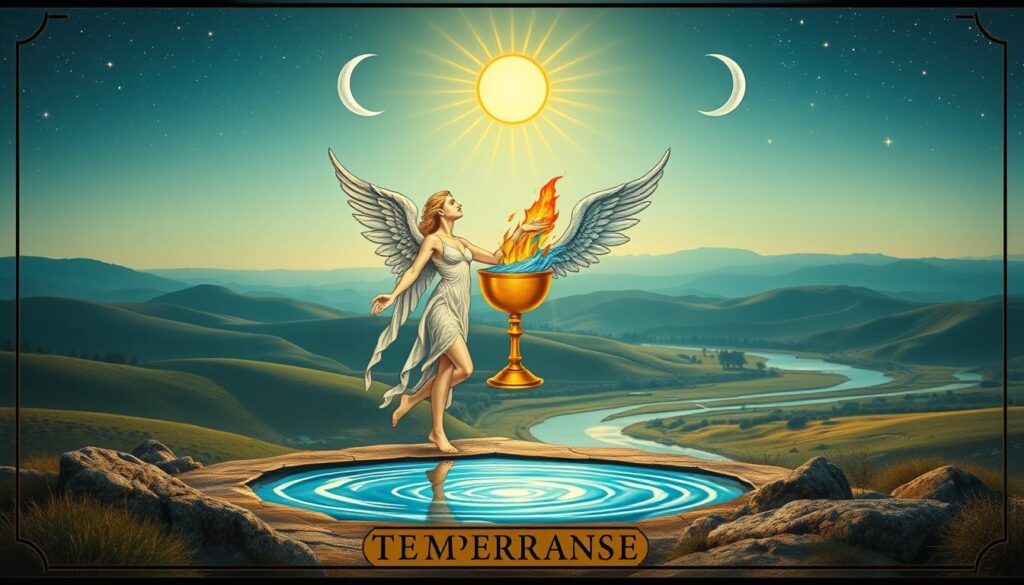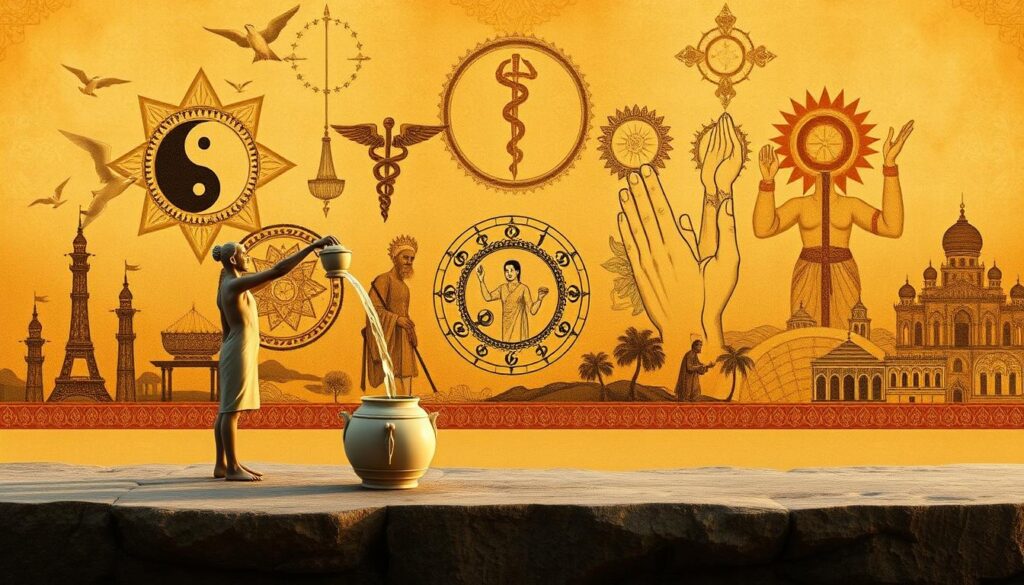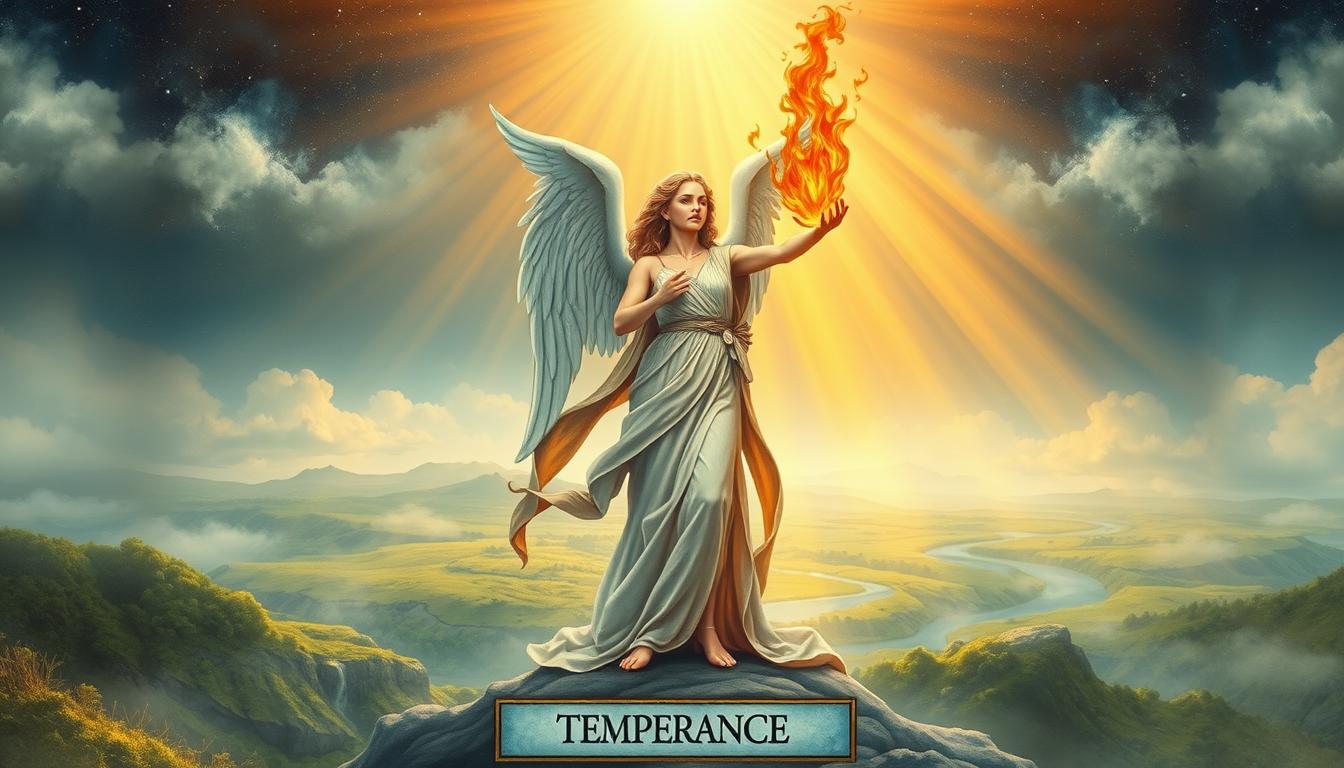The Temperance card in the Tarot deck is a powerful symbol of balance and harmony. It represents the blending of opposites, bringing together elements that seem at odds to create a unified whole. This card teaches us the importance of moderation and self-restraint in our daily lives.
Historically, the concept of Temperance has roots in Greek philosophy and religious traditions. Aristotle spoke of the virtues of self-control, while religious texts like Milton’s Paradise Lost linked it to longevity through balanced nourishment. These ideas are beautifully captured in the Tarot’s imagery.
The Temperance card often features an angel pouring liquid between two cups, symbolizing the flow of life and the blending of opposites. This visual metaphor reminds us to find balance in our actions and thoughts. Whether in relationships, work, or personal growth, this card encourages us to harmonize conflicting forces.
In this article, we’ll explore the cultural, spiritual, and practical dimensions of the Temperance card. From its historical roots to its modern applications in Tarot readings, we’ll uncover how this card can guide us toward a more balanced and fulfilling life.
Key Takeaways
- The Temperance card symbolizes harmony and balance in the Tarot deck.
- Its imagery of an angel blending liquids represents the unification of opposites.
- Historical roots trace back to Greek philosophy and religious traditions.
- Modern interpretations emphasize moderation and self-restraint.
- Practical applications include finding balance in daily life and spiritual growth.
The Essence of Temperance in Tarot
The Temperance card serves as a reminder to harmonize life’s opposing forces. It teaches us to find balance in chaos and to blend seemingly conflicting elements into a unified whole. This card is a powerful symbol of patience, flow, and the art of moderation.

Symbolism of the Temperance Card
The angelic figure on the Temperance card is a divine mediator, standing with one foot in water and the other on land. This imagery represents the blending of the subconscious and material worlds. The act of pouring water between two cups symbolizes emotional regulation and the unification of opposites.
Colors play a significant role in the card’s symbolism. Blue represents calmness and serenity, while orange signifies vitality and harmony. Together, these colors remind us to balance our inner and outer worlds.
Balancing Opposites for Harmony
Moderation is key to achieving balance. The Temperance card encourages us to avoid extremes and find a middle path. For example, balancing fire and water energies can lead to healthier relationships and personal growth.
Historically, philosophers like Aquinas and Stoics had differing views on moderation. Aquinas emphasized restraining desires, while Stoics focused on self-control. Both perspectives highlight the importance of temperance in daily practice.
| Philosopher | View on Moderation |
|---|---|
| Aquinas | Restraining desires of sensible pleasures |
| Stoics | Practicing self-control and emotional regulation |
By embracing the virtues of temperance, we can create harmony in our lives. This card reminds us that balance is not a destination but a continuous journey.
Historical Roots of Temperance
From ancient philosophies to religious teachings, temperance has been a guiding principle. Its origins trace back to Greek philosophy, where sophrosyne—the virtue of self-control—was explored in Plato’s Charmides. This concept laid the foundation for later interpretations of moderation and balance.

In Christianity, temperance became one of the four cardinal virtues, emphasizing self-restraint and moral discipline. Similarly, Hinduism’s dama in the Brihadaranyaka Upanishad highlights the importance of self-regulation. These traditions show how temperance transcends cultures and time.
From Ancient Philosophy to Modern Virtue
The evolution of temperance continued through the ages. Aristotle’s concept of habituation—practicing moderation to develop virtue—contrasts with Kant’s focus on moral duty. Both philosophies, however, stress the value of self-control in achieving harmony.
During the Prohibition Era, the temperance movement gained momentum in the United States. Organizations like the Women’s Christian Temperance Union (WCTU) advocated for abstinence, influencing the passage of the 18th Amendment. This era highlights how temperance shaped societal law and norms.
Temperance in Religious Traditions
Religious teachings have long emphasized temperance as a path to spiritual growth. In Judaism, Maimonides’ “golden mean” advocates for balance in all aspects of life. Monastic fasting practices in Buddhism and Christianity also reflect the principle of abstinence as a form of self-discipline.
Quakers contributed to modern moderation concepts, promoting simplicity and restraint. These diverse traditions illustrate how temperance remains a universal value, guiding individuals toward inner peace and ethical living.
Temperance as a Virtue Across Cultures
Across the globe, the idea of balance has shaped cultures and spiritual practices. From ancient philosophies to modern lifestyles, moderation remains a universal value. People have long sought ways to harmonize opposing forces, finding peace in the middle path.

Eastern and Western Perspectives
In the East, the Buddhist Middle Way teaches balance between indulgence and asceticism. This practice encourages people to avoid extremes, fostering inner peace. Similarly, Hinduism’s dama emphasizes self-restraint as a part of spiritual growth.
In the West, the Amish community embodies moderation through simple living. Their way of life reflects a deep commitment to balance and restraint. These diverse traditions show how temperance transcends cultural boundaries.
The Role of Moderation in Spiritual Growth
Moderation plays a key role in spiritual development. The Japanese concept of hara hachi bu—eating until 80% full—highlights the importance of self-control. This practice aligns with the Benedictine principle of ora et labora, balancing work and prayer.
Taoist water symbolism also reflects the value of flexibility and balance. As Lao Tzu said,
“Water is fluid, soft, and yielding. But water will wear away rock, which is rigid and cannot yield.”
This metaphor reminds us to embrace moderation in our daily lives.
For more insights on achieving balance, explore Hannah Brites, where practical tips and spiritual guidance await.
Interpreting Temperance in Tarot Readings
In Tarot readings, the Temperance card offers profound insights into finding balance and patience in life. Whether upright or reversed, it guides us to harmonize opposing forces and make thoughtful decisions. This card’s meaning is deeply tied to moderation and the art of blending energies.

Upright Meanings: Patience and Flow
When the Temperance card appears upright, it signifies a need for patience and a long-term vision. It encourages calm under stress, reminding us to trust the process. This position often highlights the importance of blending creative and practical energies to achieve harmony.
For example, in career decision readings, Temperance advises steady progress rather than impulsive actions. It suggests balancing work with other aspects of life to avoid burnout. This card also emphasizes divine timing, urging us to wait for the right moment to act.
Reversed Warnings: Excess and Imbalance
In its reversed position, Temperance warns against excess and imbalance. It signals the need for reflection and moderation, especially in areas like addiction recovery or financial management. This position often highlights cycles of overindulgence that disrupt harmony.
For instance, in addiction recovery contexts, reversed Temperance can indicate a lack of self-control. It urges individuals to seek balance and avoid extremes. Similarly, in finances, it advises against overspending or neglecting savings.
| Position | Interpretation |
|---|---|
| Upright | Patience, long-term vision, blending energies |
| Reversed | Excess, imbalance, need for moderation |
By understanding the meaning of Temperance in different positions, we can apply its lessons to various aspects of life. Whether upright or reversed, this card reminds us to find balance in all things and trust the flow of time.
The Alchemy of Blending Opposites
Blending opposites is an art that requires patience and balance, much like the energy of the Temperance card. This process, often called alchemy, transforms conflicting elements into harmonious unity. Whether in relationships, work, or creativity, integrating opposites can lead to profound growth and innovation.

How Temperance Encourages Integration
The Temperance card teaches us to embrace integration as a way to achieve harmony. Carl Jung’s concept of coniunctio oppositorum—the union of opposites—reflects this idea. It suggests that combining conscious and unconscious, masculine and feminine, or fire and water energies can lead to wholeness.
Montaigne once said,
“Temperance enhances pleasure by ensuring we do not overindulge.”
This principle applies to blending opposites. By finding the middle path, we can enjoy the best of both worlds without losing balance.
Practical Examples of Harmonizing Energy
In the modern workplace, merging departments like marketing and engineering can foster innovation. This integration creates a synergy that benefits the entire organization. Similarly, interfaith marriages often require mediation strategies to blend different beliefs into a unified family life.
Fusion cuisine is another great example of culinary alchemy. Combining flavors from different cultures creates unique dishes that celebrate diversity. In eco-design, integrating technology and nature leads to sustainable solutions that respect the environment.
For those seeking spiritual balance, rituals like balancing elemental energies can be powerful. For instance, using water and fire in a meditation practice can help harmonize emotions and actions. These examples show how blending opposites can enrich our lives in meaningful ways.
Temperance in Daily Life
Finding balance in daily life can transform how we approach relationships, work, and leisure. By practicing moderation, we create harmony in our routines and interactions. This section explores practical ways to integrate temperance into everyday things.

Applying Temperance to Relationships
Relationships thrive when we practice patience and moderation. One effective strategy is the 24-hour response rule, which encourages thoughtful communication during conflicts. Taking time to reflect before reacting can prevent misunderstandings and foster deeper connections.
Weekly check-ins are another way to maintain balance. Setting aside time to discuss boundaries and needs ensures both partners feel heard and valued. As Charles Darwin noted, self-command habits can be inherited and cultivated over time, making moderation a natural part of healthy relationships.
Finding Balance in Work and Leisure
Modern life often blurs the lines between work and leisure, leading to burnout. A 7-day temperance challenge for digital detox can help. By limiting screen time, we create space for rest and creativity. This practice aligns with the principle of mindful consumption, ensuring we prioritize what truly matters.
Hobby rotation systems also promote balance. Alternating between different activities prevents monotony and keeps us engaged. For financial temperance, the 50/30/20 budget rule ensures spending aligns with priorities, fostering stability and peace of mind.
“Moderation is the key to lasting happiness and fulfillment.”
| Area | Strategy |
|---|---|
| Relationships | 24-hour response rule, weekly check-ins |
| Work-Life Balance | 7-day digital detox, hobby rotation |
| Finances | 50/30/20 budget alignment |
For more tips on achieving balance, visit Hannah Brites, where you’ll find practical guidance tailored to your needs.
Modern Reflections on Temperance
Modern society is rediscovering the timeless wisdom of temperance in unexpected ways. From wellness trends to personal development, this ancient virtue is finding new relevance in our fast-paced world. Whether through sobriety movements or mindfulness practices, temperance continues to guide us toward balance and harmony.

The Card’s Relevance Today
The Temperance card’s message of balance resonates deeply in today’s world. For instance, the “sober curious” movement reflects a shift toward moderation, with non-alcoholic beverage sales rising by 29% in 2023. This trend highlights a growing preference for abstinence and mindful consumption.
Aligning with natural rhythms, such as circadian cycles, is another modern application of temperance. By syncing our routines with these biological patterns, we can achieve better health and productivity. Practices like digital minimalism also echo the monastic simplicity of the past, reminding us to prioritize what truly matters.
Temperance and Personal Growth
Personal growth often requires balancing opposing forces. Microdosing practices, for example, offer a middle ground between full abstinence and excess. Similarly, corporate wellness programs are incorporating virtue ethics to foster healthier workplaces.
Mindfulness apps like Headspace and Calm are modern tools for developing virtues such as patience and self-control. These apps encourage users to pause, reflect, and find balance in their daily lives. As Lao Tzu once said,
“Nature does not hurry, yet everything is accomplished.”
By embracing temperance, we can navigate modern challenges with grace and resilience. This timeless principle reminds us that balance is not a destination but a continuous journey.
Conclusion
Embracing balance is a journey, not a destination, and temperance offers a guiding light along the way. As Marcus Aurelius once highlighted, mastering self-restraint is a part of living a fulfilling life. This virtue isn’t a fixed state but a dynamic process that evolves with time and practice.
Start with a daily check-in: reflect on your choices and align them with moderation. A 21-day challenge can help you cultivate this habit, blending opposing forces like emotional fermentation to create harmony. By integrating temperance into your routine, you invite personal transformation and growth.
Let temperance be your alchemical tool, turning life’s challenges into opportunities for balance and self-mastery. Begin your journey today and discover the profound peace that comes from living in harmony.

